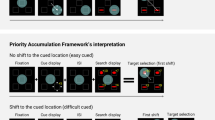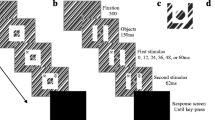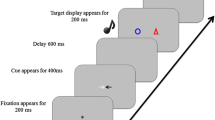Summary
It has been claimed that spatial attention plays a decisive role in the effect of irrelevant spatial stimulus-response correspondence (i. e., the Simon effect), especially the way the attentional focus is moved onto the stimulus (lateral shifting rather than zooming). This attentional-movement hypothesis is contrasted with a referential-coding hypothesis, according to which spatial stimulus coding depends on the availability of frames or objects of reference rather than on certain attentional movements. In six experiments, reference objects were made available to aid spatial coding, which either appeared simultaneously with the stimulus (Experiments 1–3), or were continuously visible (Experiments 4–6). In contrast to previous experiments and to the attentional predictions, the Simon effect occurred even though the stimuli were precued by large frames surrounding both possible stimulus positions (Experiment 1), even when the reference object's salience was markedly reduced (Experiment 2), or when the precueing frames were made more informative (Experiment 3). Furthermore, it was found that the Simon effect is not reduced by spatial correspondence between an uninformative spatial precue and the stimulus (Experiment 4), and it does not depend on the location of spatial precues appearing to the left or right of both possible stimulus locations (Experiment 5). This was true even when the precue was made task-relevant in order to ensure attentional focusing (Experiment 6). In sum, it is shown that the Simon effect does not depend on the kind of attentional operation presumably performed to focus onto the stimulus. It is argued that the available data are consistent with a coding approach to the Simon effect which, however, needs to be developed to be more precise as to the conditions for spatial stimulus coding.
Similar content being viewed by others
References
Castiello, U., & Umiltà, C. (1990). Size of the attentional focus and efficiency of processing. Acta Psychologica, 73, 195–209.
Craft, J. L., & Simon, J. R. (1970). Processing symbolic information from a visual display: Interference from an irrelevant directional cue. Journal of Experimental Psychology, 83, 415–420.
Downing, C. J., & Pinker, S. (1985). The spatial structure of visual attention. In M. I. Posner & O. S. M. Marin (Eds.), Attention and performance XI (pp. 171–187). Hillsdale, NJ: Erlbaum.
Eriksen, C. W., & St James, J. D. (1986). Visual attention within and around the field of focal attention: A zoom lens model. Perception & Psychophysics, 40, 225–240.
Fischer, B. (1986). The role of attention in the preparation of visually guided eye movements in monkey and man. Psychological Research, 48, 251–257.
Fischer, B., & Breitmeyer, B. (1987). Mechanisms of visual attention revealed by saccadic eye movements. Neuropsychologica, 25, 73–83.
Gopher, D., Karis, D., & Koenig, W. (1985). The representation of movement schemas in long-term memory: Lessons from the acquisition of a transcription skill. Acta Psychologica, 60, 105–134.
Hedge, A., & Marsh, N. W. A. (1975). The effect of irrelevant spatial correspondences on two-choice response-time. Acta Psychologica, 39, 427–439.
Heister, G., Schroeder-Heister, P., & Ehrenstein, W. H. (1990). Spatial coding and spatio-anatomical mapping: Evidence for a hierarchical model of spatial stimulus-response compatibility. In R. W. Proctor, & T. G. Reeve (Eds.), Stimulus-response compatibility (pp. 117–143). Amsterdam: North-Holland.
Hommel, B. (1993 a). Effects of irrelevant spatial S-R compatibility depend on disjunctively versus conjunctively defined response criteria. MS submitted for publication.
Hommel, B. (1993 b). Inverting the Simon effect by intention: Determinants of the direction and extent of the Simon effect. Psychological Research/Psychologische Forschung, 55, (in press).
Hommel, B. (1993 c). The relationship between stimulus processing and response selection in the Simon task: Evidence for a temporal overlap. MS submitted for publication.
Hughes, H. C., & Zimba, L. D. (1985). Spatial maps of directed visual attention. Journal of Experimental Psychology: Human Perception and Performance, 11, 409–430.
Klein, R., & McCormick, P. (1989). Covert visual orienting: Hemifield-activation can be mimicked by zoom lens and midlocation placement strategies. Acta Psychologica, 70, 235–250.
Kornblum, S., Hasbroucq, T., & Osman, A. (1990). Dimensional overlap: Cognitive basis for stimulus-response compatibility — a model and taxonomy. Psychological Review, 97, 253–270.
Lambert, A., & Hockey, R. (1991). Peripheral visual changes and spatial attention. Acta Psychologica, 76, 149–163.
Lambert, A., Spencer, E., & Mohindra, N. (1987). Automaticity and the capture of attention by a peripheral display change. Current Psychological Research and Reviews, 6, 136–147.
Lamberts, K., Tavernier, G., & d'Ydewalle, G. (1992). Effects of multiple reference points in spatial stimulus-response compatibility. Acta Psychologica, 79, 115–130.
Maylor, E. A. (1985). Facilitatory and inhibitory components of orienting in visual space. In M. I. Posner & O. S. M. Marin (Eds.), Attention and performance XI (pp. 189–204). Hillsdale, NJ: Lawrence Erlbaum.
Maylor, E. A., & Hockey, R. (1987). Effects of repetition on the facilitatory and inhibitory components of orienting in visual space. Neuropsychologica, 25, 41–54.
McCann, R. S., & Johnston, J. C. (1992). Locus of the single-channel bottleneck in dual task interference. Journal of Experimental Psychology: Human Perception and Performance, 18, 471–484.
Mewaldt, S. P., Connelly, C. L., & Simon, J. R. (1980). Response selection in choice reaction time: Test of a buffer model. Memory & Cognition, 8, 606–611.
Müller, H. J., & Rabbitt, P. M. A. (1989). Reflexive and voluntary orienting of visual attention: Time course of activation and resistance to interruption. Journal of Experimental Psychology: Human Perception and Performance, 15, 315–330.
Navon, D. (1977). Forest before trees: The precedence of global features in visual perception. Cognitive Psychology, 9, 353–383.
Nicoletti, R., & Umiltà, C. (1989). Splitting visual space with attention. Journal of Experimental Psychology: Human Perception and Performance, 15, 164–169.
Posner, M. I. (1980). Orienting of attention. Quarterly Journal of Experimental Psychology, 32, 3–25.
Posner, M. I., & Cohen, Y. (1984). Components of visual orienting. In H. Bouma & D. G. Bouwhuis (Eds.), Attention and performance X (pp. 531–555). Hillsdale, NJ: Erlbaum.
Prinz, W. (1990). A common coding approach to perception and action. In O. Neumann & W. Prinz (Eds.), Relationships between perception and action (pp. 167–201). Berlin: Springer.
Proctor, R. W., Reeve, T. G., & Van Zandt, T. (1992). Salient-feature coding in response selection. In G. E. Stelmach & J. Requin (Eds.), Tutorials in motor behavior II (pp. 727–741). Amsterdam: North-Holland.
Quinlan, P. T., & Humphreys, G. W. (1987). Visual search for targets defined by combinations of color, shape, and size: An examination of the task constraints on feature and conjunction searches. Perception & Psychophysics, 41, 455–472.
Rizzolatti, G., Riggio, L., Dascola, I., & Umiltà, C. (1987). Reorienting attention across the horizontal and vertical meridians: Evidence in favor of a premotor theory of attention. Neuropsychologia, 25, 31–40.
Schroeder-Heister, P., Heister, G., & Ehrenstein, W. H. (1988). Spatial S-R compatibility under head tilt. Acta Psychologica, 69, 35–44.
Shepherd, M., & Müller, H. J. (1989). Movement versus focusing of visual attention. Perception & Psychophysics, 46, 146–154.
Simon, J. R. (1969). Reactions toward the source of stimulation. Journal of Experimental Psychology, 81, 174–176.
Simon, J. R. (1990). The effects of an irrelevant directional cue on human information processing. In R. W. Proctor & T. G. Reeve (Eds.), Stimulus-response compatibility (pp. 31–86). Amsterdam: North-Holland.
Simon, J. R., Acosta, E., & Mewaldt, S. P. (1975). Effect of locus of warning tone on auditory choice reaction time. Memory & Cognition, 3, 167–170.
Simon, J. R., Acosta, E., Mewaldt, S. P., & Speidel, C. R. (1976). The effect of an irrelevant directional cue on choice reaction time: Duration of the phenomenon and its relation to stages of processing. Perception & Psychophysics, 19, 16–22.
Simon, J. R., Craft, J. L., & Small, A. M., Jr. (1970). Manipulating the strength of a stereotype: Interference effects in an auditory information-processing task. Journal of Experimental Psychology, 86, 63–68.
Simon, J. R., & Rudell, A. P. (1967). Auditory S-R compatibility: The effect of an irrelevant cue on information processing. Journal of Applied Psychology, 51, 300–304.
Simon, J. R., & Small, A. M., Jr. (1969). Processing auditory information: Interference from an irrelevant cue. Journal of Applied Psychology, 53, 433–435.
Sokolov, E. N. (1963). Perception and the conditioned reflex. New York: Pergamon Press.
Stoffels, E. J., Van der Molen, M. W., & Keuss, P. J. G. (1985). Intersensory facilitation and inhibition: Immediate arousal and location effects of auditory noise on visual reaction time. Acta Psychologica, 58, 45–62.
Stoffer, T. H. (1988). Dynamische Aspekte der visuellen Aufmerksamkeit: Funktionelle Charakteristika der Fokussieränderung vom Typ “Gummilinse” und ihre Beteiligung an der Entstehung der Dominanz globaler über lokale Merkmale. Unpublished Habilitationsschrift, University of Bielefeld, Germany.
Stoffer, T. H. (1991). Attentional zooming and spatial S-R compatibility. Psychological Research, 53, 127–135.
Theeuwes, J. (1991). Categorization and identification of simultaneous targets. Acta Psychologica, 76, 73–86.
Treisman, A., & Gelade, G. (1980). A feature-integration theory of attention. Cognitive Psychology, 12, 97–136.
Tsal, Y. (1983). Movements of attention across the visual field. Journal of Experimental Psychology: Human Perception and Performance, 9, 523–530.
Umiltà, C., & Liotti, M. (1987). Egocentric and relative spatial codes in S-R compatibility. Psychological Research, 49, 81–90.
Umiltà, C., & Nicoletti, R. (1990). Spatial stimulus-response compatibility. In R. W. Proctor & T. G. Reeve (Eds.), Stimulus-response compatibility (pp. 89–116). Amsterdam: North-Holland.
Umiltà, C., & Nicoletti, R. (1992). An integrated model of the Simon effect. In J. Alegria, D. Holender, J. Junça de Morais, & M. Radeau (Eds.), Analytic approaches to human cognition (pp. 331–350). Amsterdam: North-Holland.
Verfaellie, M., Bowers, D., & Heilman, K. M. (1988). Hemispheric asymmetries in mediating intention, but not selective attention. Neuropsychologia, 26, 521–531.
Wallace, R. J. (1971). S-R compatibility and the idea of a response code. Journal of Experimental Psychology, 88, 354–360.
Wallace, R. J. (1972). Spatial S-R compatibility effects involving kinesthetic cues. Journal of Experimental Psychology, 93, 163–168.
Wandmacher, J., & Arend, U. (1985). Superiority of global features in classification and matching. Psychological Research, 47, 143–157.
Warner, C. B., Juola, J. F., & Koshino, H. (1990). Voluntary allocation versus automatic capture of visual attention. Perception & Psychophysics, 48, 243–251.
Yantis, S., & Jonides, J. (1984). Abrupt visual onsets and selective attention: Evidence from visual search. Journal of Experimental Psychology: Human Perception and Performance, 10, 601–621.
Yantis, S., & Jonides, J. (1990). Abrupt visual onsets and selective attention: Voluntary versus automatic allocation. Journal of Experimental Psychology: Human Perception and Performance, 16, 121–134.
Author information
Authors and Affiliations
Rights and permissions
About this article
Cite this article
Hommel, B. The role of attention for the Simon effect. Psychol. Res 55, 208–222 (1993). https://doi.org/10.1007/BF00419608
Received:
Accepted:
Issue Date:
DOI: https://doi.org/10.1007/BF00419608




